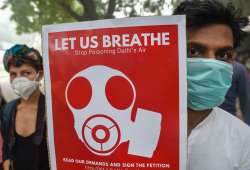How to check air quality in your area. 3 simple steps
Delhi is choking with unimaginable levels of pollution this season. You should know what local air quality means to your health. To gauge the quality of air around you, you can simply check the Air Quality Index (AQI) in your area. Here are three simple steps to check your AQI.

Delhi is choking with unimaginable levels of pollution this season. You should know what local air quality means to your health. To gauge the quality of air around you, you can simply check the Air Quality Index (AQI) in your area. This will help you understand how clean or polluted your air is, and what associated health effects might be a concern for you. AQI is a yardstick running from 0 to 500. The higher the AQI value, the greater the level of air pollution and the health concern.
How to check air quality in your area: Follow 3 simple steps
Step 1: Visit AQI official site
Step 2: Type the name of your city (eg: Delhi, Mumbai)
Step 3: Now, type the name of your area (eg: Karol Bagh, Virar)
The Air Quality Index (AQI) for your chosen area will be displayed. You will also be able to see the number of fires around the selected place.
| AIR QUALITY INDEX | CONDITION |
| 0 to 50 | Good |
| 51 to 100 | Moderate |
|
101 to 150
|
Unhealthy for Sensitive Groups |
| 151 to 200 | Unhealthy |
| 201 to 300 | Very Unhealthy |
| 301 to 500 | Hazardous |
Understanding AQI: What it means
0 to 50 AQI - Good: Satisfactory air quality, poses little or no risk.
51 to 100 AQI - Moderate: Acceptable air quality. However, there may be a moderate health concern for a very small number of people. For example, people who are unusually sensitive to ozone may experience respiratory symptoms.
101 to 150 AQI - Unhealthy for Sensitive Groups: Although general public is not likely to be affected at this AQI range, people with lung disease, older adults and children are at a greater risk from exposure to ozone, whereas persons with heart and lung disease, older adults and children are at greater risk from the presence of particles in the air.
151 to 200 AQI - Unhealthy: Everyone may begin to experience some adverse health effects, and members of the sensitive groups may experience more serious effects.
201 to 300 AQI - Very Unhealthy: This would trigger a health alert signifying that everyone may experience more serious health effects.
Over 300 AQI - Hazardous: This would trigger a health warning of emergency conditions. The entire population is more likely to be affected.
ALSO READ | Delhi's Air Quality Index worst in the world, Lahore second
ALSO READ | Delhi Air Quality Woes: Hospitals see rise in respiratory complications